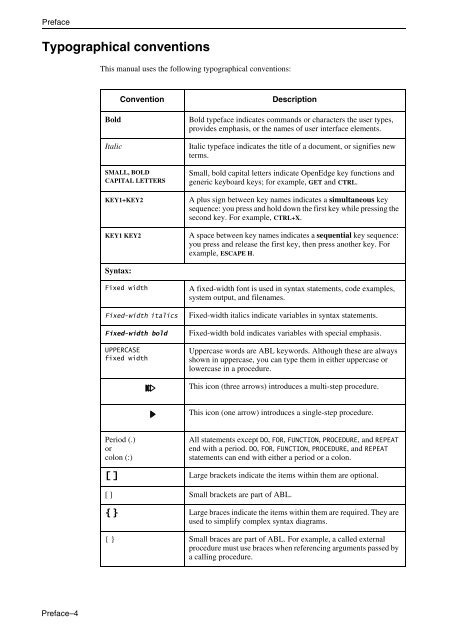OpenEdge Development: Working with XML - Product ...
OpenEdge Development: Working with XML - Product ...
OpenEdge Development: Working with XML - Product ...
Create successful ePaper yourself
Turn your PDF publications into a flip-book with our unique Google optimized e-Paper software.
Preface<br />
Typographical conventions<br />
Preface–4<br />
This manual uses the following typographical conventions:<br />
Convention Description<br />
Bold Bold typeface indicates commands or characters the user types,<br />
provides emphasis, or the names of user interface elements.<br />
Italic Italic typeface indicates the title of a document, or signifies new<br />
terms.<br />
SMALL, BOLD<br />
CAPITAL LETTERS<br />
Small, bold capital letters indicate <strong>OpenEdge</strong> key functions and<br />
generic keyboard keys; for example, GET and CTRL.<br />
KEY1+KEY2 A plus sign between key names indicates a simultaneous key<br />
sequence: you press and hold down the first key while pressing the<br />
second key. For example, CTRL+X.<br />
KEY1 KEY2 A space between key names indicates a sequential key sequence:<br />
you press and release the first key, then press another key. For<br />
example, ESCAPE H.<br />
Syntax:<br />
Fixed width A fixed-width font is used in syntax statements, code examples,<br />
system output, and filenames.<br />
Fixed-width italics Fixed-width italics indicate variables in syntax statements.<br />
Fixed-width bold Fixed-width bold indicates variables <strong>with</strong> special emphasis.<br />
UPPERCASE<br />
fixed width<br />
Period (.)<br />
or<br />
colon (:)<br />
[ ]<br />
Uppercase words are ABL keywords. Although these are always<br />
shown in uppercase, you can type them in either uppercase or<br />
lowercase in a procedure.<br />
This icon (three arrows) introduces a multi-step procedure.<br />
This icon (one arrow) introduces a single-step procedure.<br />
All statements except DO, FOR, FUNCTION, PROCEDURE, and REPEAT<br />
end <strong>with</strong> a period. DO, FOR, FUNCTION, PROCEDURE, and REPEAT<br />
statements can end <strong>with</strong> either a period or a colon.<br />
Large brackets indicate the items <strong>with</strong>in them are optional.<br />
[ ] Small brackets are part of ABL.<br />
{ }<br />
Large braces indicate the items <strong>with</strong>in them are required. They are<br />
used to simplify complex syntax diagrams.<br />
{ } Small braces are part of ABL. For example, a called external<br />
procedure must use braces when referencing arguments passed by<br />
a calling procedure.
















